Curcumin in Health and Diseases: Alzheimer's Disease and Curcumin Analogues, Derivatives, and Hybrids
- PMID: 32183162
- PMCID: PMC7139886
- DOI: 10.3390/ijms21061975
Curcumin in Health and Diseases: Alzheimer's Disease and Curcumin Analogues, Derivatives, and Hybrids
Abstract
Worldwide, Alzheimer's disease (AD) is the most common neurodegenerative multifactorial disease influencing the elderly population. Nowadays, several medications, among them curcumin, are used in the treatment of AD. Curcumin, which is the principal component of Curcuma longa, has shown favorable effects forsignificantly preventing or treating AD. During the last decade, the scientific community has focused their research on the optimization of therapeutic properties and on the improvement of pharmacokinetic properties of curcumin. This review summarizes bibliographical data from 2009 to 2019 on curcumin analogues, derivatives, and hybrids, as well as their therapeutic, preventic, and diagnostic applications in AD. Recent advances in the field have revealed that the phenolic hydroxyl group could contribute to the anti-amyloidogenic activity. Phenyl methoxy groups seem to contribute to the suppression of amyloid-β peptide (Aβ42) and to the suppression of amyloid precursor protein (APP) andhydrophobic interactions have also revealed a growing role. Furthermore, flexible moieties, at the linker, are crucial for the inhibition of Aβ aggregation. The inhibitory activity of derivatives is increased with the expansion of the aromatic rings. The promising role of curcumin-based compounds in diagnostic imaging is highlighted. The keto-enol tautomerism seems to be a novel modification for the design of amyloid-binding agents. Molecular docking results, (Q)SAR, as well as in vitro and in vivo tests highlight the structures and chemical moieties that are correlated with specific activity. As a result, the knowledge gained from the existing research should lead to the design and synthesis ofinnovative and multitargetedcurcumin analogues, derivatives, or curcumin hybrids, which would be very useful drug and tools in medicine for both diagnosis and treatment of AD.
Keywords: Alzheimer’sdisease; curcumin analogues; derivatives; diagnosis; hybrids; therapy.
Conflict of interest statement
The authors declare no conflict of interest.
Figures
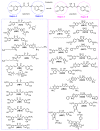
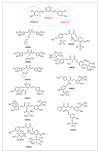




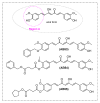

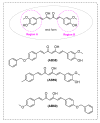
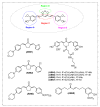





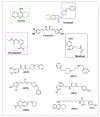


Similar articles
-
Relationship between the tautomeric structures of curcumin derivatives and their Abeta-binding activities in the context of therapies for Alzheimer's disease.Biomaterials. 2010 May;31(14):4179-85. doi: 10.1016/j.biomaterials.2010.01.142. Epub 2010 Feb 23. Biomaterials. 2010. PMID: 20181392
-
Inhibitory Activity Of Curcumin Derivatives Towards Metal-free And Metal-induced Amyloid-β Aggregation.Curr Alzheimer Res. 2015;12(5):415-23. doi: 10.2174/1567205012666150504150125. Curr Alzheimer Res. 2015. PMID: 25938870
-
Synthetic Curcumin Analogs as Inhibitors of β -Amyloid Peptide Aggregation: Potential Therapeutic and Diagnostic Agents for Alzheimer's Disease.Mini Rev Med Chem. 2015;15(13):1110-21. doi: 10.2174/138955751513150923101841. Mini Rev Med Chem. 2015. PMID: 26420724 Review.
-
Keto form of curcumin derivatives strongly binds to Aβ oligomers but not fibrils.Biomaterials. 2021 Mar;270:120686. doi: 10.1016/j.biomaterials.2021.120686. Epub 2021 Jan 23. Biomaterials. 2021. PMID: 33540171
-
Supplementation with Curcuma longa Reverses Neurotoxic and Behavioral Damage in Models of Alzheimer's Disease: A Systematic Review.Curr Neuropharmacol. 2019;17(5):406-421. doi: 10.2174/0929867325666180117112610. Curr Neuropharmacol. 2019. PMID: 29338678 Free PMC article.
Cited by
-
The emerging role of autophagy and mitophagy in tauopathies: From pathogenesis to translational implications in Alzheimer's disease.Front Aging Neurosci. 2022 Oct 17;14:1022821. doi: 10.3389/fnagi.2022.1022821. eCollection 2022. Front Aging Neurosci. 2022. PMID: 36325189 Free PMC article. Review.
-
High Yield Synthesis of Curcumin and Symmetric Curcuminoids: A "Click" and "Unclick" Chemistry Approach.Molecules. 2022 Dec 30;28(1):289. doi: 10.3390/molecules28010289. Molecules. 2022. PMID: 36615495 Free PMC article.
-
Therapeutic Approach to Alzheimer's Disease: Current Treatments and New Perspectives.Pharmaceutics. 2022 May 24;14(6):1117. doi: 10.3390/pharmaceutics14061117. Pharmaceutics. 2022. PMID: 35745693 Free PMC article. Review.
-
New Possibilities in the Therapeutic Approach to Alzheimer's Disease.Int J Mol Sci. 2022 Aug 10;23(16):8902. doi: 10.3390/ijms23168902. Int J Mol Sci. 2022. PMID: 36012193 Free PMC article. Review.
-
Novel Insights into the Therapeutic Potential of Curcumin and Derivatives.Int J Mol Sci. 2023 May 16;24(10):8837. doi: 10.3390/ijms24108837. Int J Mol Sci. 2023. PMID: 37240182 Free PMC article.
References
-
- Attitudes to dementia-World Alzheimer Report 2019. [(accessed on 26 January 2020)]; Available online: https://www.alz.co.uk/research/WorldAlzheimerReport2019.pdf.
-
- Kandel E.R., Schwartz J.H., Jessell T.M., Siegelbaum S.A., Hudspeth A.J. Principles of Neural Science. 5th ed. McGraw-Hill Education; New York, NY, USA: 2013.
-
- Song J.-X., Malampati S., Zeng Y., Durairajan S.S.K., Yang C.-B., Tong B.C.-K., Iyaswamy A., Shang W.-B., Sreenivasmurthy S.G., Zhu Z., et al. A small molecule transcription factor EB activator ameliorates beta-amyloid precursor protein and Tau pathology in Alzheimer’s disease models. Aging Cell. 2020;19:e13069. doi: 10.1111/acel.13069. - DOI - PMC - PubMed
Publication types
MeSH terms
Substances
LinkOut - more resources
Full Text Sources
Medical
Research Materials
Miscellaneous

